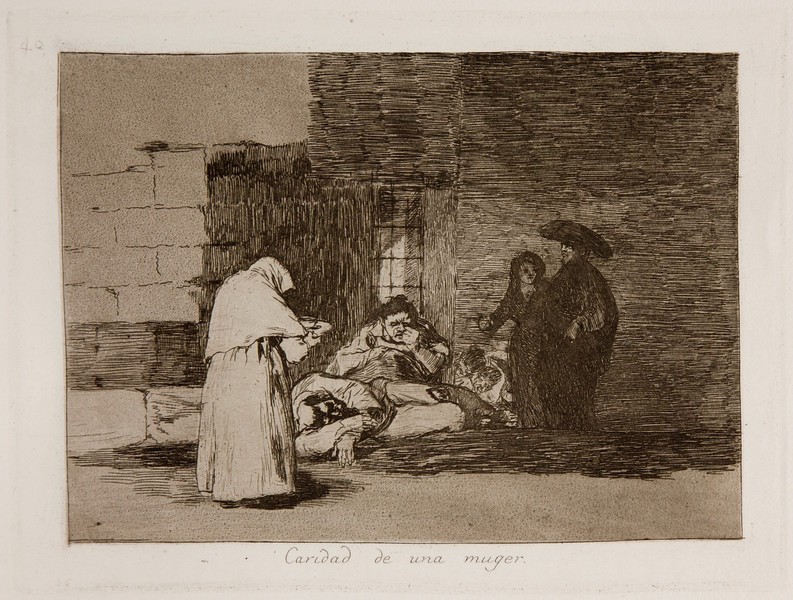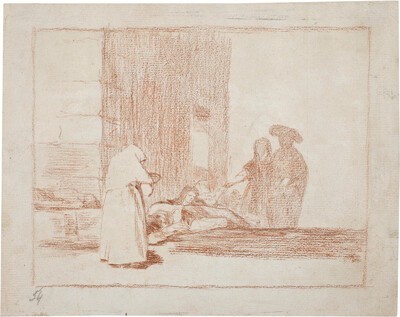- Cronología
- Ca. 1812 - 1815
- Dimensiones
- 156 x 208 mm
- Técnica y soporte
- Aguafuerte, buril, lavis y bruñidor
- Reconocimiento de la autoría de Goya
- Undisputed work
- Ficha: realización/revisión
- 15 Dec 2010 / 16 Jun 2025
- Inventario
- 225
36 (on the lower left-hand corner).
See Sad presentiments of what must come to pass.
The title was handwritten on the print by Goya in the first and only series that is known to have been printed at the time the works were created, which the artist gave to his friend Agustín Ceán Bermúdez. Therefore, the title was etched into the plate at a later date and left unchanged as of the first edition of the Disasters of War printed by the San Fernando Royal Academy of Fine Arts in Madrid in 1863, after the printing of the series in the possession of Ceán Bermúdez.
There is a surviving preparatory drawing for this print which is housed in the Prado Museum.
A woman covered from head to toe is shown carrying a plate that she is offering to a group of figures lying on the ground before her, exhausted by hunger and perhaps on the point of death. A short distance behind this group on the right-hand side of the composition an obese priest watches the scene unfolding with indifference - perhaps because he is accustomed to such sights, so typical in times of war.
The scene reflects on the one hand the famine that plagued the population during the Spanish War of Independence, in particular between 1811 and 1812. On the other hand, it reflects the lack of solidarity shown by the most affluent classes - especially within the Church - and the help that was given spontaneously by those who had little to offer.
The figure completely covered by a tunic is reminiscent of the work of Salvator Rosa (Naples, 1615-Rome, 1673), which Goya might have been familiar with from his stay in Italy from 1769 to 1771. Goya also produced panneggio (drapery) exercises featuring fully covered figures in his Italian Sketchbook which might be related to the work Charon passant les ombres (Charon Ferrying Dead Souls Across the Styx) (Louvre Museum, Paris, 1735) by Pierre Subleyras (Saint-Gilles-du-Gard, 1699 - Rome, 1749).
La plancha se conserva en la Calcografía Nacional (cat. 300).
-
Francisco Goya. Sein leben im spiegel der graphik. Fuendetodos 1746-1828 Bordeaux. 1746-1996Galerie KornfeldBern1996from November 21st 1996 to January 1997cat. 151
-
Francisco Goya. Capricci, follie e disastri della guerraSan Donato Milanese2000Opere grafiche della Fondazione Antonio Mazzottacat.129
-
Goya. Opera graficaPinacoteca del Castello di San GiorgioLegnano2006exhibition celebrated from December 16th 2006 to April 1st 2007p. 75
-
Goya et la modernitéPinacothèque de ParisParís2013from October 11st 2013 to March 16th 2014cat. 88
-
2022
-
Goya, grabadorMadridBlass S.A.1918cat. 151
-
Goya engravings and lithographs, vol. I y II.OxfordBruno Cassirer1964cat. 169
-
Vie et ouvre de Francisco de GoyaParísOffice du livre1970cat. 1072
-
Catálogo de las estampas de Goya en la Biblioteca NacionalMadridMinisterio de Educación y Cultura, Biblioteca Nacional1996cat. 258
-
ParísPinacoteca de París2013p. 144
-
Goya. In the Norton Simon MuseumPasadenaNorton Simon Museum2016pp. 114-151
-
Museo de Bellas Artes de Badajoz y Diputación de Badajoz2022p. 70

